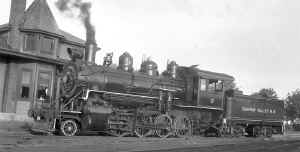RAHWAY VALLEY RAILROAD ROSTER
-
B&LE-Bessemer & Lake Erie Research/Chart: Richard J. King 2008
-
L&NE-Lehigh & New England
-
O&W-Oneida & Western
-
G&U-Grafton & Upton
-
P&LE-Pittsburgh & Lake Erie
-
PRR-Pennsylvania
-
LV- Lehigh Valley
New York and New Orange No.1, New Orange Four
Junction No.1
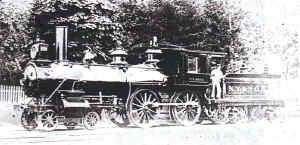
Collection of Thomas T. Taber, III
4-4-0 American
Name- "New Orange"
Term- 1899-1903
Built- 1869
Builder- PRR-Juniata
PRR Class C, later D-3
Specifications:
Locomotive Weight- 39.5 Tons
Tender Weight- 25.7 Tons
Driver Size- 62 inches
Length- 54 ft. 5 inches
Height- 14 ft. 8 inches
Fuel Type- Soft Coal
Fuel Capacity- 4 Tons
Water Capacity- 2,400 Gallons
No.1 was a 4-4-0 American type built in 1869 by the Pennsylvania Railroad's
Juniata Locomotive Shops in Altoona, PA as their No.322. It served as a
passenger and freight locomotive for many years before being retired in the
1890s, being replaced by larger power. While on the PRR it belonged to the C
class and in 1895 it became part of the D-3 class. The NY&NO
purchased No.1 along with Nos. 2 and 3 in 1898 for passenger and freight
use. No.1 arrived after Nos. 2 and 3, in 1899. No.1 arrived inoperable
and it was reconditioned to operation. During 1899 the NY&NO found
itself with no customers when the factories in New Orange shut down from an
industrial recession. Nos.1-3 were therefore used infrequently, and only
used to pull the passenger trains to the CNJ. The NY&NO was foreclosed
on November 8, 1900 and was sold to the New Orange Four Junction Railroad on
February 16, 1901. No.1 was rarely used while under the ownership of the
NOFJ, with No.3 being the preferred locomotive. Nos.1 and 2 were scrapped in
1903.
New York and New Orange No.2, New Orange Four Junction No.2
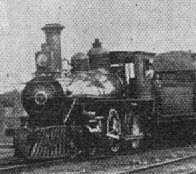
4-4-0 American
Term- 1898-1903
Built- 1870s
Builder- PRR-Juniata
PRR Class C, later D-3
Specifications:
Locomotive Weight- 39.5 Tons
Tender Weight- 25.7 Tons
Driver Size- 62 inches
Length- 54 ft. 5 inches
Height- 14 ft. 8 inches
Fuel Type- Soft Coal
Fuel Capacity- 4 Tons
Water Capacity- 2,400 Gallons
No.2 was a 4-4-0 American type built in the 1870s by the Pennsylvania
Railroad's Juniata Locomotive Shops in Altoona, PA. It served as a passenger
and freight locomotive for many years before being retired in the 1890s,
being replaced by larger power. While on the PRR it belonged to the C
class and in 1895 it became part of the D-3 class. The NY&NO
purchased No.2 along with Nos. 1 and 3 in 1898 for passenger and
freight use. During 1899 the NY&NO found itself with no customers
when the factories in New Orange shut down from an industrial recession.
Nos.1-3 were therefore used infrequently, and only used to pull the
passenger trains to the CNJ. The NY&NO was foreclosed on November 8,
1900 and was sold to the New Orange Four Junction Railroad on February 16,
1901. No.2 was rarely used while under the ownership of the NOFJ, with No.3
being the preferred locomotive. Nos.1 and 2 were scrapped in 1903.
New York and New Orange No.3, New Orange Four Junction No.3, Rahway
Valley No.3
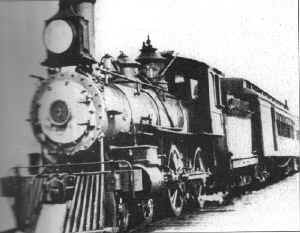
Collection of Mary E. McCoy
4-4-0 American
Term- 1898-1906
Built- 1870s
Builder- PRR-Juniata
PRR Class C, later D-3
Specifications:
Locomotive Weight- 39.5 Tons
Tender Weight- 25.7 Tons
Driver Size- 62 inches
Length- 54 ft. 5 inches
Height- 14 ft. 8 inches
Fuel Type- Soft Coal
Fuel Capacity- 4 Tons
Water Capacity- 2,400 Gallons
No.3 was a 4-4-0 American type built in the 1870s by the Pennsylvania
Railroad's Juniata Locomotive Shops in Altoona, PA. It served as a passenger
and freight locomotive for many years before being retired in the 1890s,
being replaced by larger power. While on the PRR it belonged to the C
class and in 1895 it became part of the D-3 class. The NY&NO
purchased No.3 along with Nos. 1 and 2 in 1898 for passenger and
freight use. During 1899 the NY&NO found itself with no customers
when the factories in New Orange shut down from an industrial recession.
Nos.1-3 were therefore used infrequently, and only used to pull the
passenger trains to the CNJ. The NY&NO was foreclosed on November 8,
1900 and was sold to the New Orange Four Junction Railroad on February 16,
1901. No.3 became the preferred locomotive of the NOFJ and on March 1, 1905,
along with the NOFJ, No.3 was purchased by the Rahway Valley Railroad. It
was the only locomotive to serve each railroad, the NY&NO, the NOFJ, and
the RV. No.3 was unfortunately wrecked in a crash in 1906 and was scrapped.
Rahway Valley No.4
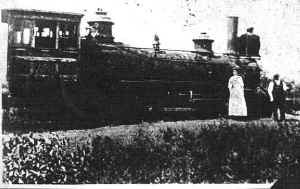
Collection of Thomas T. Taber, III
2-6-0 Mogul
Term- 1904-1918
Built- 1870
Builder- Dickson
DL&W 300 Class
Specifications:
Locomotive Weight- 44.8 Tons
Driver Size- 57 inches
Fuel Type- Coal
No.4 was the first locomotive purchased by the Rahway Valley Railroad, and
it is unclear if it was numbered 4 right away, or after the NOFJ was
purchased in 1905. In any case, No.4 was purchased from the Delaware
Lackawanna and Western Railroad in 1904. No.4 was a member of the
Lackawanna's 300 class built in 1870 by the Dickson Locomotive Works. By the
time it arrived on the RV it was already 34 years old. No.4 was what
railroaders would call a "tea kettle" for it's small size and low
pulling power. No.4 was always in poor condition and after the purchase of
Nos. 5 and 6 in 1905, and No.7 in 1908 it saw little use. No.4 did handle the effort
to remove the soil of Tin Kettle Hill and sell it to the PRR. An
examination of the locomotive in 1909 revealed that the boiler needed repair
and needed a hydrostatic test, and the flues and steam gauges needed to be
replaced. No.4 saw use as a track maintenance locomotive and helped to build
the branch to Maplewood in 1911, and then raise it in 1915-1916. No.4 saw
more use in the rush of World War I period of 1914-1918 when there was much
activity on the line. No.4 was scrapped in 1918.
Rahway Valley No.5
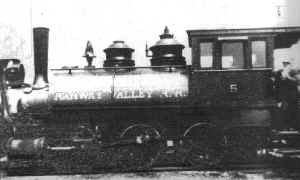
Collection of Mary E. McCoy
0-6-0T Saddle Tank Switcher
Term- 1904-1922
Built- 8/1882
Builder- Baldwin
CNJ 23, later 710
No.5 was one of five identical locomotives built from 1880 to 1882 for the
Central Railroad of New Jersey, No.5 was the last to be built in August
1882. No.5 was originally numbered 23 on the CNJ until 1903 when it was
renumbered to 710, the identical switchers became 705-709. No.710
performed switching chores for the CNJ until it was purchased by
the Rahway Valley Railroad in 1905. No.5 was soon accompanied by SIRT No.6
which was also purchased that year by the line. No.5 was great for light
switching jobs and it also handled the smaller passenger trains, but it had
difficultly with the 4% grades up to Summit. When rail-buses were
acquired in 1911, No.5 was basically put out to pasture. No.7 handled the
long passenger trains, which were now infrequent, No.6 handled freight, and
the rail-buses got most of the time on the passenger trains. No.5 was put
into storage with the infrequently used No.4. When the first rail bus was
scrapped in 1914 and the other retired the regular steam powered passenger
trains came back. No.5 was put back into service and the beginning of the
first World War gave all four Rahway Valley locomotives work. After the end
of the war in 1918 and the bringing back of the railbus in 1919, No.5 was kept as backup to the railbus until Roger Clark pulled the plug on all
passenger trains in 1922 and No.5 was sold to a contractor. Who knows, maybe
old No.5 is around, somewhere.
Rahway Valley No.6
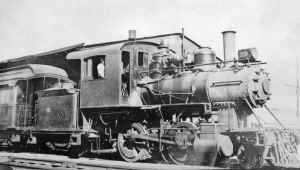
Note: Unit No.10 of the SIRT. Identical to RV No.6,
a former SIRT unit. Collection: Joseph A. Smith
2-4-4
Term- 1905-1917
Built- ????
Builder- Baldwin
SIRT
Of all the Rahway Valley Railroad locomotives, No.6's story has been the
hardest to determine. I have found two sources that agree that No.6 was from
the Staten Island Rapid Transit line, a New York commuter railroad. One
source says that No.6 was a 2-4-0, but going by the fact of how little that
configuration was used, I am going to go with the other source stating it
was a 2-4-4, commonly referred to as a Mason Bogie. No.6 was acquired by the
Rahway Valley in 1905 and was used mainly for passenger use. Until
1908, No.6 was the main passenger locomotive. That year brand new No.7 was
acquired, and No.6 was most likely used in tandem with No.7, as at this time
there we 14 passenger trains a day. By 1909 daily passenger trains were down
to six, so No.6 was only used when No.7 was down for repairs. In 1911 the rail buses
were acquired and No.6 was put as a backup to them as well. In
1914, the railbuses were done away with, and World War I started. Nos. 4, 5,
6, and 7 put in a lot of overtime hours drilling the line for passenger
trains, freight trains, and trains of workers to the factories. There was so
much work to be done that locomotives had to be leased for a time. Toward
the latter part of the war Nos. 6 and 7 were purchased for use in Europe in
1917. No.6 might still exist somewhere, who knows.
Rahway Valley No.7
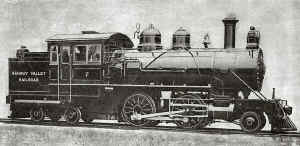
2-4-4
Term- 1908-1917
Built- 1908
Builder- Baldwin
Builder No. 32817
Specifications:
Locomotive Weight- 75 Tons
Driver Size- 56 inches
Cylinders- 17" x 24"
Fuel Type- Coal
No.7 has a specific distinction on the Rahway Valley Railroad, it was the
only new steam locomotive on the line. In 1908, Louis Keller contracted
with the Baldwin Locomotive Works in Philadelphia, NY to build a high
stepping locomotive for his line. No.7 arrived new from the factory and
quickly became the pride and joy of the crew. It was also the most used
engine on the line. It could easily negotiate the tight curves and steep
grades of the Rahway Valley. Management attempted to replace No.7 in 1911
with two rail buses, but venerable No.7 was still used for the larger
passenger trains that the buses could not handle. In 1914, the rail buses
were done away with and No.7 continued working the passenger trains. When
World War I broke out in 1914, business picked up greatly on the line, and
No.7 was definitely kept busy. No.7 worked for nine years on the line before
being sold in 1917 and shipped off to Spain. It later was shipped to Brazil
and worked the logging trains in the rain forest there up until World War
II. Who knows, maybe this locomotive still exists in some third world
country, Cuba still operates steam locomotives I believe.
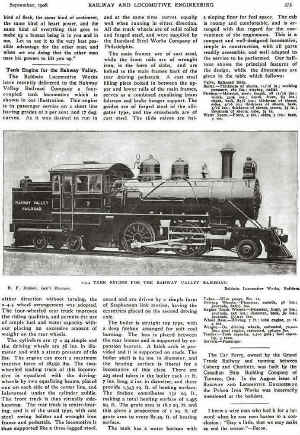 RVRR
No. 7 article September 1908
RVRR
No. 7 article September 1908
RAILWAY AND LOCOMOTIVE ENGINEERING
Rahway Valley No.8
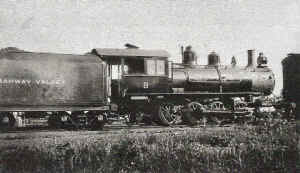
Collection of Thomas T. Taber, III
2-8-0 Consolidation
Term- 1916-1929
Built- 1900
Builder- Pittsburgh
Builder No. 2070
PL&E 1772
Specifications:
Locomotive Weight- 72 Tons
Driver Size- 50 inches
Cylinders- 20" x 26"
Fuel Type- Coal
No.8 was the first of three locomotives acquired in the World War I rush of
1914-1918. No.8 was built by the Pittsburgh Locomotive Works in 1900 to
haul coal on the Pittsburgh and Lake Erie Railroad in Pennsylvania and
served as their No.1772. It came east in 1916 when the Rahway Valley
purchased it. No.8 was very reliable and saw much use on the line from 1916
to 1918. After the end of World War I things seriously slowed on the Rahway
Valley and it sank into the red. At the end of the war in 1918 the Rahway
Valley had Nos. 5, 8, 9, and 10. No.5 was rarely used only when the railbus
was under repairs, and even that was on it's last legs. Nos. 9 and 10
were only used when needed, which wasn't often, only when No.8 required
repairs. In 1920 Louis Keller purchased another locomotive, No.11. From 1920
until 1929 Nos. 8 and 11 were the workhorses of the railroad. Nos. 5 was
sold in 1922 and Nos. 9 and 10 were sold in the 1920s to General Equipment
Co. After Keller died in 1922, Roger Clark took over, the railbus was
disposed of, and the roaring twenties were here. Clark began to pull the
line out of it's pool of debt. Nos. 8 and 11 gradually saw more use and a
third locomotive was purchased in 1927, No.12, which was too big for use on
the line. No.8 stuck around for a while longer before Clark got enough money
to invest in the purchase of two more locomotives, Nos.13 and 14, which
replaced Nos. 8 and 11. No.8 was scrapped in April, 1929.
Rahway Valley No.9
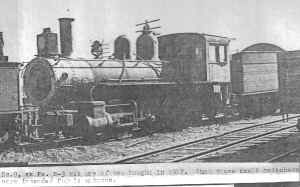
Collection of Thomas T. Taber, III
0-6-0 Switcher
Term- 1917-1920s
Built- 11/1893
Builder- Juniata
PRR Class B-3
Specifications:
Locomotive Weight- 46 Tons
Driver Size- 50 inches
Cylinders- 19" x 24"
Fuel Type- Coal
No.9 was the second of the three locomotives purchased in the World War I
rush. No.9 was built in November, 1893 at the Pennsylvania Railroad's
Juniata Shops in Altoona, PA. It worked at the PRR's yards until it was
purchased in 1917 by the Rahway Valley Railroad. No.9 was purchased along
with identical locomotive No.10 to replace recently sold Nos. 6 and 7 and
also for the war time rush. After the end of the war in 1918, No.9 saw very
little use, only as a backup to No.8. By 1920 when No.11 was purchased, No.9
had almost completely lost all it's use on the Rahway Valley. Nos. 9 and 10
were sold to General Equipment Co. sometime in the 1920s after very short
careers on the railroad.
Rahway Valley No.10
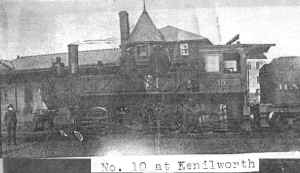
Collection of Thomas T. Taber, III
0-6-0 Switcher
Term- 1917-1920s
Built- 11/1893
Builder- Juniata
PRR Class B-3
Specifications:
Locomotive Weight- 46 Tons
Driver Size- 50 inches
Cylinders- 19" x 24"
Fuel Type- Coal
No.10 was the third of the three locomotives purchased in the World War
I rush. No.10 was built in November, 1893 at the Pennsylvania Railroad's
Juniata Shops in Altoona, PA. It worked at the PRR's yards until it was
purchased in 1917 by the Rahway Valley Railroad. No.10 was purchased along
with identical locomotive No.9 to replace recently sold Nos. 6 and 7 and
also for the war time rush. After the end of the war in 1918, No.9 saw very
little use, only as a backup to No.8. By 1920 when No.11 was purchased,
No.10 had almost completely lost all it's use on the Rahway Valley. Nos. 9
and 10 were sold to General Equipment Co. sometime in the 1920s after very
short careers on the railroad.
Rahway Valley No.11
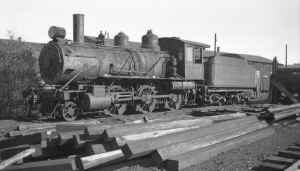 Photo: 5/31/40 Kenilworth
Photo: 5/31/40 Kenilworth
2-6-0 Mogul
Term- 1920-1937
Built- 3/1904
Builder- Baldwin
M&WR 11, G&U 5
Specifications:
Locomotive Weight- 60 Tons
Driver Size- 57 inches
Cylinders- 19" x 26"
Fuel Type- Coal
No.11 was built new for a shortline, the Grafton and Upton Railroad, in
February, 1904 by Baldwin. On the G&U it was numbered 5. The sixty ton
locomotive was purchased by the Rahway Valley Railroad in 1920 to
essentially replace Nos. 9 and 10, which were 14 tons lighter than No.11.
The locomotive was the second Mogul purchased by the railroad, and unlike
it's predecessor No.11 worked well, and was reliable. The locomotive also
had the added distinction of being the last locomotive purchased during the
lifetime of Louis Keller. No.11 served along with No.8 during the 1920s
hauling freight on a line highly in debt. Roger Clark came to the presidency
of the line in 1922 and in 1927 he purchased another locomotive, No.12, but
it was too heavy. Then in 1929, Clark had Nos. 13 and 14 purchased and
they replaced Nos.8, 11, and 12. No. 8 was scrapped, No.12 was retired, and
No.11 was put on standby for the day that Nos. 13 and 14 would both be in
the shop. In about 1933, No.11 was brought in the shops for
inspection and work and it was found that the locomotive was completely worn
out. No.11 was retired and sidelined along with No.12. When No.15 was
purchased in 1937, No.11 was immediately scrapped.
Rahway Valley No.12
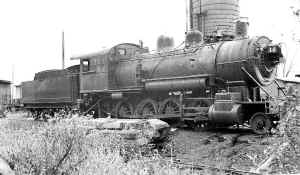
2-8-0 Consolidation
Term- 1927-1943
Built- 1902-3
Builder- Alco (Pittsburgh)
B&LE 96
Specifications:
Locomotive Weight- 87 Tons
Driver Size- 48 inches
Cylinders- 22" x 28"
Fuel Type- Coal
If you worked for the Rahway Valley Railroad in 1928, you could describe
No.12 in two words "BIG NUISANCE." No.12 started out as Bessemer
and Lake Erie No.96 built in either 1902 or 1903 by the American
Locomotive Company's (Alco) Pittsburgh Works. No.12 was an in and out coal
hauling locomotive. Then in 1927, Roger Clark had purchased the locomotive
for the upturn in freight traffic. Clark obviously did not fully think
out the idea of this 87 ton behemoth on his railroad's light 60 lbs. to the
yard rail. No.12 worked well on the grades, there was no denying it that,
but on the other hand, it split the rails, broke them, and crews prayed as
the coal-hauler crossed the line's bridges. To give you an idea of how heavy
this locomotive was for the little Rahway Valley, years later in the
late-1960s, the Whippany based operation, the Morris County Central offered
to run it's 0-6-0 Army Switcher over the RV for a few days. The RV had to
decline, the locomotive was too heavy, and that locomotive weighs 79 tons,
No.12 weighed in at 87 tons. When Nos. 13 and 14 were purchased in 1929,
No.12 was immediately retired. No.12 may have operated a few times between
1933 and 1937 when No.11 was out of service and the line had no backup
locomotive. No.12 lived the rest of it's life sitting dead on a siding in
Kenilworth until it was finally scrapped in February, 1943.
Rahway Valley No.13
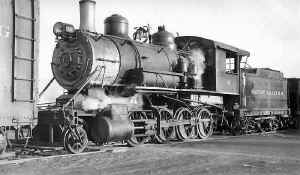
2-8-0 Consolidation
Term- 1929-1952
Built- 9/1905
Builder- Baldwin (Burnham, Williams, and Co.)
Builder No. 26355
L&NE 19 E-7
Specifications:
Locomotive Weight- 74 Tons
Driver Size- 50 inches
Cylinders- 20" x 26"
Tractive Effort- 35,000 lbs.
Fuel Capacity- 8 Tons
Fuel Type- Coal
No.13 started life out as Lehigh & New England No.19. Rahway Valley Nos.
13 and 14 were two out of three members of the L&NE E-7 class, the
other being L&NE No.18. All three were built in September, 1905 by
Baldwin subsidiary, Burnham, Williams, and Company. No.13 worked reliably on
the L&NE for 24 years before being sold to the Rahway Valley in 1929
along with No.14. They both replaced Nos. 8, 11, and 12 as the main
locomotives on the RV. No.8 was scrapped, No.12 retired, and No.11 was put
on as backup to the two new acquisitions. Nos. 13 and 14 got a new
stablemate, No.15 in 1937. Nos.13 and 14 were the workhorses on the line,
and No.15 served simply as a backup to them. The two twin consolidations
became the symbol for the Rahway Valley, and No.13 worked reliably on the
railroad for many, many years. No.13 finally lost out to new diesel power on
January 29, 1951 when No.16 arrived on the line. No.14 was scrapped, and
Nos. 13 and 15 were put in the shop for the day that the diesel would be
down for repairs. Occasionally traffic was great enough that the diesel and
a steam locomotive would work together on the same day. No.13 saw it's
demise come when it was scrapped in 1952 after 47 years of faithful service.
Rahway Valley No.14
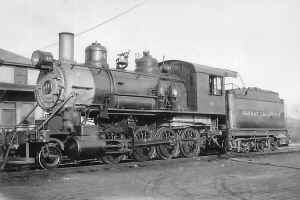
2-8-0 Consolidation
Term- 1929-1951
Built- 9/1905
Builder- Baldwin (Burnham, Williams, and Co.)
Builder No. 26356
L&NE 20 E-7
Specifications:
Locomotive Weight- 74 Tons
Driver Size- 50 inches
Cylinders- 20" x 26"
Tractive Effort- 35,000 lbs.
Fuel Capacity- 8 Tons
Fuel Type- Coal
No.14 started life out as Lehigh & New England No.19. Rahway Valley Nos.
13 and 14 were two out of three members of the L&NE E-7 class, the
other being L&NE No.18. All three were built in September, 1905 by
Baldwin subsidiary, Burnham, Williams, and Company. No.13 worked reliably on
the L&NE for 24 years before being sold to the Rahway Valley in 1929
along with No.13. They both replaced Nos. 8, 11, and 12 as the main
locomotives on the RV. No.8 was scrapped, No.12 retired, and No.11 was put
on as backup to the two new acquisitions. Nos. 13 and 14 got a new
stablemate, No.15 in 1937. Nos.13 and 14 were the workhorses on the line,
and No.15 served simply as a backup to them. The two twin consolidations
became the symbol for the Rahway Valley, and No.14 worked reliably on the
railroad for many, many years. No.14 finally lost out to new diesel power on
January 29, 1951 when No.16 arrived on the line. No.14 was scrapped that
year after 46 years of faithful service to two railroads.
Rahway Valley No.15
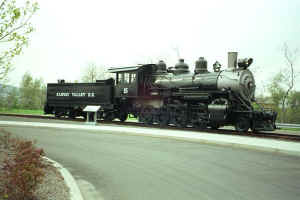
2-8-0 Consolidation
Term- 1937-1959
Built- 6/1916
Builder- Baldwin
Builder No. 43529
O&W 20
Specifications:
Locomotive Weight- 73 Tons
Driver Size- 50 inches
Cylinders- 20" x 26"
Tractive Effort- 33,360 lbs.
Fuel Capacity- 6 Tons
Fuel Type- Coal
Water Capacity- 3,500 Gallons
Boiler Pressure- 600 lbs. per square inch
No.15 was built for a Tennessee short line, the Oneida & Western
Railroad as their No.20. The engine was the pride and joy of the crew, and
was often used. Then in 1926, a neglectful let the locomotive freeze
overnight, and ice broke the locomotive's bridges. It was sent to Baldwin
for repairs. And Baldwin strangely fitted the locomotive with outside piston
valves, a new steel pilot, a new reverse mechanism, and a lubricator. The
locomotive went back to work in the hills of Tennessee for another eleven
years before it was deemed surplus and put up for sale. Master Mechanic Carl
Nees, Charlottesville, VA native, was sent to look over the locomotive, and
he had it purchased for the Rahway Valley. The southern girl came north and
soon the crew took a liking to her. Engineer Frank Froat really liked the
sound of her southern whistle, and could toot it like no one else. No.15 was
only a backup to Nos. 13 and 14 though. They were real workhorses, and in
the winter they were the preference for their full wrap around cabs,
which No.15 did not feature. While No.15 was not the workhorse, it certainly
was the prettiest locomotive of the line. Diesel power arrived on January
29, 1951, in the form of GE 70 ton switcher No.16. No.14 was scrapped, and
Nos.13 and 15 put on standby to the diesel for the day it would be in the
shop, or when traffic was heavy enough for two locomotives. No.15 lost it's
longtime steam stablemate, No.13 in 1952 when it was scrapped, but No.15 was
retained for the same purpose it had always had on the RV, backup. No.15
operated for the last time on the RV on November 28, 1953, when No.16 was
down for repairs. A second diesel, No.17 arrived on February 2, 1954, and
steam was permanently retired on the RV, 56 years after Nos. 2 and 3 arrived
at Aldene Junction. George Clark did not want to see No.15 go up for scrap,
and he contemplated putting it on display in Kenilworth, but space was
limited. Clark sold No.15 to F. Nelson Blount in May, 1959, and it was
shipped on June 5, to Wakefield, Massachusetts.
Once in Massachusetts the locomotive was put on display,
but then Blount had his steam locomotive collection to Keene, NH, then to
North Walpole, NH, and finally to Bellows Falls, VT. While in North Walpole,
No.15 was overhauled and put into service for Blount's tourist line, the
Monadnock Northern. In 1962-1963 starred in a movie titled, "The
Cardinal" and ran to Boston for the picture. After Blount's death in
1968 the locomotive was put into service on the Green Mountain Railroad. In
January, 1973, Steamtown obtained a flue extension and installed a new
piston and piston road. And the locomotive was leased out for a couple days
for a wealthy couple's wedding in Boston. In August, 1973, the
locomotive's front was modified, when its headlight was center mounted and
number plate placed underneath the headlight. It only operated shortly with
this appearance for on August 12, 1973, during "Friends of Steamtown
Day" while the locomotive was triple-heading, broke a flue, and badly
scalded veteran engineer, Andy Barbera. That was the last time No.15
operated. In 1987, the locomotive moved to Steamtown's new location in
Scranton, PA and has remained there since, and it's headlight was high
mounted again. Not much work is needed to restore the locomotive to
operation. The locomotive is currently not in it's RV paint scheme.
Rahway Valley No.16
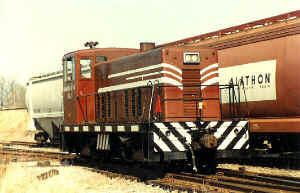 RVRR
#16 at Roselle Park 05/14/1985
RVRR
#16 at Roselle Park 05/14/1985
Photo/Archive: John Humes
B-B
Term- 1951-1989
Built- 1/1951
Builder- General Electric
Builder No. 30838
Specifications:
Locomotive Weight- 70 Tons
600 Horsepower
6 Cylinders
Cooper-Bessemer FWL-6T Prime Mover
No.16 has two special distinctions on the Rahway Valley. It was the first
diesel on the RV, and it had the longest operating span on the railroad,
longer than any other locomotive, an impressive 38 years. No.16 was
purchased new from General Electric in 1950 for $100,000, and in January,
1951 it was built and on January 29, 1951 it arrived at Aldene Jct. from the
plant in Erie, PA. It immediately replaced No.14, and put Nos. 13 and 15 on
standby. The locomotive arrived in a darker shade of red with yellow stripes
and lettering, a scheme it would maintain for 24 years. No.16 was joined by
No.17 on February 2, 1954, and No.15 was sold in 1959, then after the RV was
a diesel only line. Nos. 16 and 17 worked doggedly through the 1960s when
the Rahway Valley conducted a fairly busy freight business. In 1975 after
the death of RV president, Robert G. Clark, Bernard Cahill became president
and had the locomotive painted in identical maroon and white paint schemes.
The two locomotives looked very handsome when for a week in 1980 they pulled
passenger coaches for the U.S. Open at the Baltusrol Golf Club. In April,
1986, the Rahway Valley companies became property of the Delaware Otsego
System when the line couldn't purchase liability insurance. No.16 became
property of the DO and for another three years it worked it's home rails
until in 1989 it was replaced by larger EMD power and Nos. 16 and 17 worked
in Binghamton, NY, Passaic, NJ, and Cooperstown, NY to name a few. Then in
1995 the DO donated the locomotives to the United Railway Historical
Society. They sat in storage in many place before in the early 2000s the
Whippany Railway Museum leased them from the URHS, and so far No.16 has been
cosmetically restored.
Rahway Valley No.17
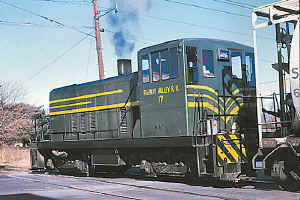 RVRR #17 in green livery crossing Kenilworth Boulevard in 1970
RVRR #17 in green livery crossing Kenilworth Boulevard in 1970
Photo: Tom Piccirillo
B-B
Term- 1954-1989
Built- 1/1954
Builder- General Electric
Builder No. 32130
Specifications:
Locomotive Weight- 70 Tons
600 Horsepower
6 Cylinders
Cooper-Bessemer FWL-6T Prime Mover
No.17 was the last locomotive purchased by the RV and ended all steam
operations on the line. No.17 was purchased new from General Electric
in 1953 for $100,000, and in January, 1954 it was built and on February
2, 1954 it arrived at Aldene Jct. from the plant in Erie, PA. It permanently
retired No.15 on the RV. The locomotive arrived in a dark forest
green with yellow stripes and lettering, a scheme it would maintain for
21 years. No.15 was sold in 1959, then after the RV was a diesel only
line. Nos. 16 and 17 worked doggedly through the 1960s when the Rahway
Valley conducted a fairly busy freight business. In 1975 after the death of
RV president, Robert G. Clark, Bernard Cahill became president and had the
locomotive painted in identical maroon and white paint schemes. The two
locomotives looked very handsome when for a week in 1980 they pulled
passenger coaches for the U.S. Open at the Baltusrol Golf Club. In April,
1986, the Rahway Valley companies became property of the Delaware Otsego
System when the line couldn't purchase liability insurance. No.16 became
property of the DO and for another three years it worked it's home rails
until in 1989 it was replaced by larger EMD power and Nos. 16 and 17 worked
in Binghamton, NY, Passaic, NJ, and Cooperstown, NY to name a few. Then in
1995 the DO donated the locomotives to the United Railway Historical
Society. They sat in storage in many place before in the early 2000s the
Whippany Railway Museum leased them from the URHS. No.17 is reported to be
operational, and is currently in primer awaiting it's new coat of paint.
